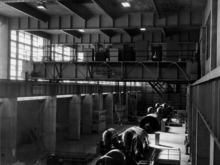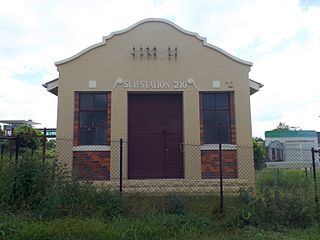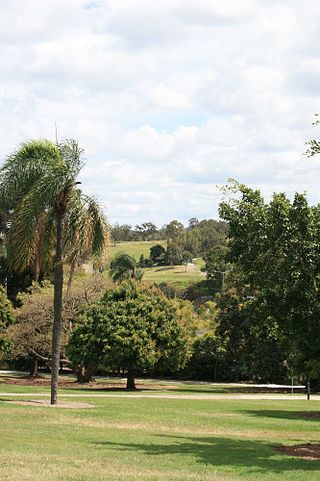1925-1938
In 1925, the greater Brisbane City Council (BCC) was created, from the old City of Brisbane, City of South Brisbane and various smaller Towns (Hamilton, Ithaca, Sandgate, Toowong, Windsor and Wynnum) and Shires (Balmoral, Belmont, Coorparoo, Enoggera, Kedron, Moggill, Sherwood, Stephens, Taringa, Tingalpa, Toombul and Yeerongpilly).
CEL held the 'franchise' for the former Brisbane and South Brisbane Council areas, and when the BCC decided to take over the generation and distribution of electricity, it offered to purchase CEL in 1926, the offer being rejected. Council had taken over the tramways network with three small powerhouses, none with enough capacity for expansion of the electricity network. To be able to expand, Council decided to construct a new powerhouse, and in 1928, the New Farm Powerhouse (now known as the Brisbane Powerhouse) became operational. [3] The station had an initial capacity of 18.75 MW, expanding to 93.75 MW upon completion. The Countess St power station was decommissioned in the same year.


CEL opened the Bulimba A power station in 1926 with an initial capacity of 12.5 MW, this being expanded to 92.5 MW by 1944. The William St power station was closed in 1931, and the plant sold to the Evans & Deakin engineering company. No longer able to expand its customer base in Brisbane, CEL commenced a program of rural electrification.
In addition to supplying the tramways network, the New Farm Powerhouse also allowed for the construction of an 11 kV network to supply power for electric light. Previously CEL had supplied these area under 10 year orders, but with Council having a new powerhouse, they slowly inherited the new areas of supply as each order expired. By 1935, only the old City of Brisbane and City of South Brisbane were still supplied by CEL, with the rest of Brisbane supplied by the BCC Electricity Supply Department.
| Former Council Area | Year Electricity transferred to BCC |
|---|---|
| Ithaca | 1926 |
| Yerongpilly | 1928 |
| Hamilton | 1930 |
| Balmoral | 1930 |
| Coorparoo | 1930 |
| Stephens | 1930 |
| Sherwood | 1931 |
| Wynnum | 1932 |
| Taringa | 1932 |
| Windsor | 1933 |
| Toowong | 1934 |
| Toombul | 1934 |
| Enoggera | 1935 |
Electricity Substations
Four initial 11 kV Substations were constructed in 1928 by Council at: Victoria Park (No.4), Lang Park (No. 6), Victoria Street, Woolloongabba (No. 9) and Cairns St, Kangaroo Point (No.11). By 1930 they had constructed four more 11 kV Substations: Balmoral (No. 12), Stephens (now Moorooka) (No. 13), Hamilton (No. 5), and Coorparoo (No. 10). [4] These substations were supplied with 11 kV, and had to transform down to 5 kV, which was the voltage that CEL had constructed in these areas. The primary purpose initially was to supply residential areas with electric light, as electricity was an expensive commodity, and most houses did not use it for any other purposes.
These substations were constructed in accordance with the designs of long term City Architect Alfred Herbert Foster (A.H.Foster, born 1873 - 23 March 1932). He joined the old City of Brisbane in 1913 as an Architectural Assistant to the City Engineer, and was made City Architect upon the formation of the greater Brisbane City Council. [5] Harold Austen Erwood (H.A.Erwood, born c.1884 - 1947) was Foster's long term assistant and successor, working as an Architect with Foster at the old City of Brisbane, from 1914, then at the greater Brisbane City Council after 1925, until Foster's death in 1932. Erwood had to wait to be appointed City Architect however, and was still waiting in August 1932. [6] BCC finally changed his designation from Chief Architectural Assistant to Chief Architect on 30 April 1933. [7] Reyburn Jameson (Born c.1880 - 1950) was employed as an Assistant Architect from 1926–1929. South African born Jameson was previously employed as a draftsman by CEL from 1918-1920 and the City of Brisbane from 1921–1922. All three men appear to have been made Registered Architects from 14 June 1929, when the Architects Registration Act 1929 was enacted. [8]
The substation buildings near or in residential areas were designed by Foster to fit in with residential areas, with similar designs employed by his successor Erwood. [4]
Details of the brick building substations by Foster and Erwood are below.
| Name | Original No | Post 1963 No | Details |
|---|---|---|---|
| Kedron | 2 | 202 | Designed by Erwood. No longer existing, replaced by a later operational 33 kV Substation. |
| Victoria Park | 4 | 204 | Designed by Foster. Existing, Local Heritage listed Substation (Decommissioned) |
| Hamilton | 5 | 205 | No longer existing, replaced by a later Local Heritage listed Substation. |
| Lang Park | 6 | 206 | Designed by Foster. No longer existing. |
| Victoria St, Woolloongabba | 9 | 209 | Designed by Foster? No longer existing. |
| Main Ave, Coorparoo | 10 | 210 | Designed by Jameson. Existing, State Heritage listed Substation (Decommissioned by 1977). |
| Cairns St, Kangaroo Point | 11 | 211 | Designed by Foster. Existing, Local Heritage listed Substation (Decommissioned by 1995). |
| Balmoral | 12 | 212 | Original building designed by Foster and later expanded by Erwood. Existing, and operational local Heritage listed Substation (minor network role only). |
| Moorooka | 13 | 213 | Original building (then called Stephens) designed by Foster. The site was expanded in 1942 to incorporate a 2nd building by Frank Gibson Costello. Existing, and operational local Heritage listed Substation. |
| Holland Park | 30 | 230 | Designed by Erwood. No longer existing, demolished and replaced by operational 33 kV substation. |
| Toowong | 31 | 231 | Designed by Erwood. No longer existing, demolished and replaced by operational 33 kV substation. |
| Nundah | 37 | 237 | Designed by Erwood. Existing, and operational local heritage listed substation, later upgraded to 33 kV. |
| Newmarket | 38 | 238 | Designed by Erwood. It was possibly his last substation as 39 & 40 were by Frank Costello. Existing, and operational local heritage listed substation, later upgraded to 33 kV. |
Half of the interwar period brick substation buildings in the table above no longer exist, some have been replaced by newer substations that have been heritage listed. These substations were constructed to take supply from the New Farm Powerhouse, and when BCC constructed the new Tennyson Powerhouse, the 11 kV substations lost their importance, with the new Tennyson 33 kV network and Zone Substations taking over their role. BCC had been having voltage drop problems, and while initially they installed 11 kV feeder regulators with tap changers on the edge of the network, including Toowong substation, the new 33 kV network was able to resolve this problem. [9]

Erwood designed Kedron, Hamilton, Toowong and Holland Park Substations, which no longer exist. His remaining examples are the Nundah and Newmarket Substations, and while both the original brick buildings survive, both sites have been expanded and upgraded to 33 kV/11 kV Zone Substations. Kedron Substation site is still in use as a 33 kV zone substation, but Erwoods's original building, built c.1933 was designed to take underground 11 kV supply from the New Farm Powerhouse. Kedron Substation was also where the BCC's 33 kV transmission line to Somerset dam originated, which was constructed on-site about the same time as the substation. A photo of the site taken in 1950 with the new enclosed 33 kV building and the old 11 kV building side by side is here (Brisbane City Council). Similarly, there is another photo of the beautiful original Holland Park Substation taken in 1953 (Brisbane City Council),
The old Coorparoo Street Lighting Substation, located at Main Avenue, Coorparoo was constructed in May 1930 for the new 'Series' system street lighting. While there were already three 5 kV street lighting substation buildings, Coorparoo Substation (No. 10) was the first BCC 11 kV public lighting substation building, and by 1940, there were three such buildings. Coorparoo Substation was fed from the old Woolloongabba (No.9) Substation with 11 kV, which it then converted to 5 kV. The 'series' system was replaced by the 'parallel' system of street lighting by 1965, with the last of the 'series' system removed by 1977, with the Coorparoo Substation (No. 10) made redundant and decommissioned. The plans for the substation were signed by Reyburn Jameson (rather than Foster) which is perhaps why, unlike the other substation, it is made out of 200 mm concrete blocks, the only pre-World War Two Brisbane substation to be built of such materials. [4] The site is still owned by Brisbane City Council, and has become far more visible from Old Cleveland Road, with the construction of the Eastern Busway in 2011, resulting in the demolition of homes between the substation and Old Cleveland Road, giving a much clearer views of the building from that road, as well as Main Avenue. The demolition of the Bowls Club for the Eastern Busway also resulted in the building becoming far more prominent with much more clear space around the site.
The interwar BCC 11 kV substation buildings have "a landmark quality due to its picturesque design, which was the result of a decision by the City Architect of the period, A.H. Foster, to limit the visual impact of Electrical Supply Department substations in residential areas by drawing on contemporary domestic architecture. The small industrial building reflects the prestige that the BCC associated with its electrification drive of the late 1920s and 1930s" [4]
This style of substation was discontinued from 1940 with the dismissal of Erwood, when a new Council was elected, although the differing priorities brought by World War Two had already effectively meant that the Newmarket Substation built in 1938 was the last of its kind. The next City Architect, Frank Costello would bring a very different style of substation building design, seen to be far more in keeping with the wishes of the newly elected Brisbane City Council, headed by John Beals Chandler as Mayor and with his Citizens' Municipal Organisation aligned Councillors. On 16 July 1940, it was reported that 5 Executive Officers of the Council had been sacked, with Erwood one of them, after 26 years of service. Erwood was reported to have said: "In wartime anything is possible, but this came as a complete surprise to me [10]














